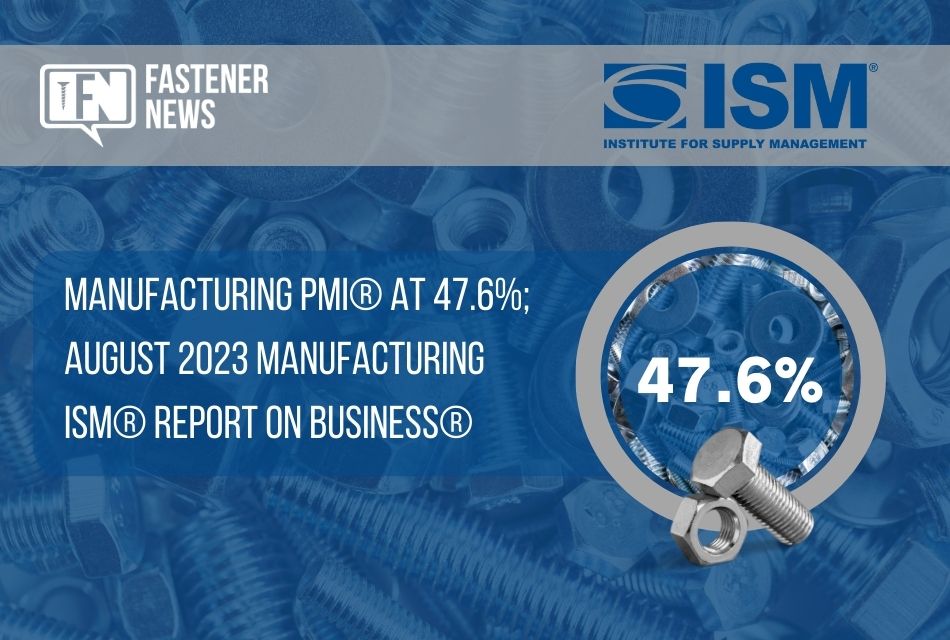Manufacturing PMI® at 47.6%; August 2023 Manufacturing ISM® Report On Business®

NEWS PROVIDED BY: Institute for Supply Management
New Orders, Employment and Backlogs Contracting; Supplier Deliveries Faster; Raw Materials Inventories Contracting; Customers’ Inventories Too Low; Prices Decreasing; Exports and Imports Contracting
, /PRNewswire/ — Economic activity in the manufacturing sector contracted in August for the 10th consecutive month following a 28-month period of growth, say the nation’s supply executives in the latest Manufacturing ISM® Report On Business®.
The report was issued today by Timothy R. Fiore, CPSM, C.P.M., Chair of the Institute for Supply Management® (ISM®) Manufacturing Business Survey Committee:
“The August Manufacturing PMI® registered 47.6 percent, 1.2 percentage points higher than the 46.4 percent recorded in July. Regarding the overall economy, this figure indicates a ninth month of contraction after a 30-month period of expansion. The New Orders Index remained in contraction territory at 46.8 percent, 0.5 percentage point lower than the figure of 47.3 percent recorded in July. The Production Index reading of 50 percent is a 1.7-percentage point increase compared to July’s figure of 48.3 percent. The Prices Index registered 48.4 percent, up 5.8 percentage points compared to the July figure of 42.6 percent. The Backlog of Orders Index registered 44.1 percent, 1.3 percentage points higher than the July reading of 42.8 percent. The Employment Index registered 48.5 percent, up 4.1 percentage points from July’s reading of 44.4 percent.
“The Supplier Deliveries Index figure of 48.6 percent is 2.5 percentage points higher than the 46.1 percent recorded in July. This is the highest reading in the past 11 months. (Supplier Deliveries is the only ISM® Report On Business® index that is inversed; a reading of above 50 percent indicates slower deliveries, which is typical as the economy improves and customer demand increases.)
“The Inventories Index decreased by 2.1 percentage points to 44 percent; the July reading was 46.1 percent. The New Export Orders Index reading of 46.5 percent is 0.3 percentage point higher than July’s figure of 46.2 percent. The Imports Index remained in contraction territory, registering 48 percent, 1.6 percentage points lower than the 49.6 percent reported in July.”
Fiore continues, “The U.S. manufacturing sector shrank again, but the uptick in the PMI® indicates a slower rate of contraction. The August composite index reading reflects companies managing outputs appropriately as order softness continues, but the month-over-month increase is a sign of improvement. Demand eased again, with the (1) New Orders Index contracting at a slightly faster rate, (2) New Export Orders Index continuing in contraction territory, with minimal signs of improvement and (3) Backlog of Orders Index improving for the third straight month but remaining at low levels. The Customers’ Inventories Index reading indicated appropriate buyer/supplier tension, which is neutral to slightly positive for future production. Output/Consumption (measured by the Production and Employment indexes) was positive, with a combined 5.8-percentage point upward impact on the Manufacturing PMI® calculation. Panelists’ companies stabilized production compared to July and continued to manage head counts, primarily through attrition. Inputs — defined as supplier deliveries, inventories, prices and imports — continued to accommodate future demand growth. The Supplier Deliveries Index indicated faster deliveries for the 11th straight month, and the Inventories Index remained in contraction territory as panelists’ companies continued to mitigate inventories exposure. The Prices Index remained in ‘decreasing’ territory but increased a respectable 5.8 percentage points, signifying near price stability. Sentiment improved regarding manufacturing lead times, although they remain at elevated levels.
“Of the six biggest manufacturing industries, three — Transportation Equipment; Food, Beverage & Tobacco Products; and Petroleum & Coal Products — registered growth in August.
“Demand remains soft, but production execution is consistent with new, reduced output levels based on panelists’ companies order books. Suppliers continue to have capacity. Prices are generally stable. Sixty-two percent of manufacturing gross domestic product (GDP) contracted in August, down from 92 percent in July, a positive trend for the economy. Additionally, the share of manufacturing GDP registering a composite PMI® calculation at or below 45 percent — a good barometer of overall manufacturing weakness — was 15 percent in August, compared to 25 percent in July and 44 percent in June, a clear positive,” says Fiore.
The five manufacturing industries that reported growth in August are: Printing & Related Support Activities; Transportation Equipment; Food, Beverage & Tobacco Products; Petroleum & Coal Products; and Miscellaneous Manufacturing. The 13 industries reporting contraction in August — in the following order — are: Apparel, Leather & Allied Products; Furniture & Related Products; Plastics & Rubber Products; Primary Metals; Fabricated Metal Products; Textile Mills; Electrical Equipment, Appliances & Components; Chemical Products; Computer & Electronic Products; Paper Products; Wood Products; Nonmetallic Mineral Products; and Machinery.
WHAT RESPONDENTS ARE SAYING
- “Further reductions in customer orders due to the economic situation and also their working down of own inventories. Backlog is dwindling, but still showing robust revenue.” [Computer & Electronic Products]
- “Demand still weak. Customer inventories are getting depleted; however, we are not seeing a real uptick in demand. General supply conditions are softening.” [Chemical Products]
- “Still seeing a slowdown in orders. We’re continuing to ship to max capacity, with supply constraints still a real part of our day-to-day business operations.” [Transportation Equipment]
- “Customer orders have softened. This is likely due to customers’ increased confidence in the supply chain, (which) has them reducing their inventories. Customers are also being pinched with higher interest rates. Additionally, consumers are feeling their purchasing power eroded by stubbornly high inflation, so they are purchasing less.” [Food, Beverage & Tobacco Products]
- “Fourth quarter orders falling short of projection and indicating a slowdown in customer demand, though the first quarter forecast remains solid. Unclear if this is an inventory correction. Logistics stabilized and costs are matching 2019. Shortages limited to only a few items now, but suppliers are hesitant to add or replace labor needed in light of slowing demand.” [Fabricated Metal Products]
- “General slowdown in business at the end of the third quarter. For capital equipment additions, our customers are buying only what they need for specific jobs and not adding any capital fleet material for potential future work.” [Machinery]
- “There is additional softening in the market. Customers are hesitant to provide extended forecasts with today’s economic uncertainty.” [Electrical Equipment, Appliances & Components]
- “Business continues to remain strong with sales and profits both ahead of plan. The bookings were below what we planned, but that was expected due to fewer working days and summer vacations.” [Miscellaneous Manufacturing]
- “The manufacturing sector continues to be slow, and the low market prices make it difficult to stay profitable. On the positive side, laborers are showing enthusiastic employment interest. Rising energy and fuel prices are of concern to our company.” [Paper Products]
- “Business is beginning to improve moderately. Still well below 2022 levels, but it appears that the ‘great inventory rebalancing’ is finally coming to fruition.” [Plastics & Rubber Products]
- “Automotive volume remains strong in preparation for the United Auto Workers’ potential strike at Ford, General Motors and Stellantis. Contingency plans in place for sub-tiers. Continue to have issues recruiting general labor employees. Operational efficiency suffering due to a lack of human resources. Order book remains strong and ahead of 2022.” [Primary Metals]
- “(The Federal Reserve’s) actions to increase borrowing costs has dampened demand for residential investment. Recently, this slowdown plateaued somewhat, with demand stabilizing. The outlook for 2024 remains uncertain, and we continue to be cautious about building inventories.” [Wood Products]
RELATED CONTENT:
Ignite Your Industry Impact: IFE 2023 Unleashes A New Era of Fastener Excellence
IFE 2023 Fastener Hall of Fame and Young Fastener Professional of the Year Inductees













Leave a Reply